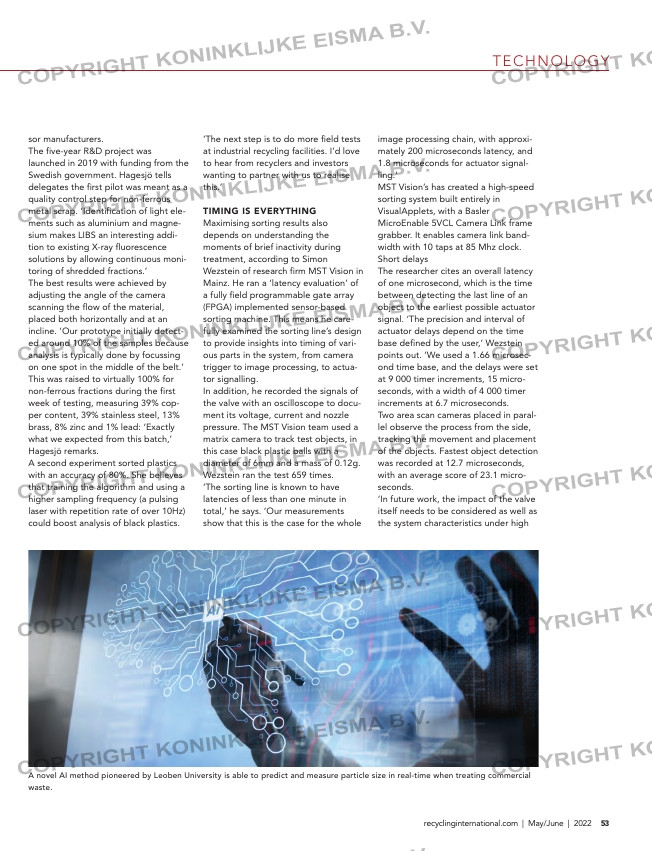Page 53 from: Recycling International May issue | 2022

TECHNOLOGY
53recyclinginternational.com | May/June | 2022
Sorting plastic flakes consumes 2.6
times more energy for the valves and
1.9 times more compressed air than
the same amount of C&D material.
‘This can be explained by the lower
particle weight of the plastic flakes,’
Ludwig explains.
The activation duration of the valves is
reduced when sorting plastic flakes,
leading to 45% lower average air con-
sumption levels compared to sorting
C&D waste. ‘The sorting quality is not
affected by this. It lies between 89%
and 99.5%,’ the researcher notes. In
the case of C&D waste, the values
were between 91.9% and 99.6%.
THE POWER OF LIBS
Louise Hagesjö of research lab Swerim
in Stockholm described laser-induced
breakdown spectroscopy (LIBS) as a
‘fast, contactless and flexible tech-
nique’ for the chemical analysis of vari-
ous materials. Her team created a test-
bed known as SenSoRe to track the
innovative sorting method (using
robotic sorting and artificial intelli-
gence as well) while also building a
platform to share know-how with other
research institutes, recyclers and sen-
sor manufacturers.
The five-year R&D project was
launched in 2019 with funding from the
Swedish government. Hagesjö tells
delegates the first pilot was meant as a
quality control step for non-ferrous
metal scrap. ‘Identification of light ele-
ments such as aluminium and magne-
sium makes LIBS an interesting addi-
tion to existing X-ray fluorescence
solutions by allowing continuous moni-
toring of shredded fractions.’
The best results were achieved by
adjusting the angle of the camera
scanning the flow of the material,
placed both horizontally and at an
incline. ‘Our prototype initially detect-
ed around 10% of the samples because
analysis is typically done by focussing
on one spot in the middle of the belt.’
This was raised to virtually 100% for
non-ferrous fractions during the first
week of testing, measuring 39% cop-
per content, 39% stainless steel, 13%
brass, 8% zinc and 1% lead: ‘Exactly
what we expected from this batch,’
Hagesjö remarks.
A second experiment sorted plastics
with an accuracy of 80%. She believes
that training the algorithm and using a
higher sampling frequency (a pulsing
laser with repetition rate of over 10Hz)
could boost analysis of black plastics.
‘The next step is to do more field tests
at industrial recycling facilities. I’d love
to hear from recyclers and investors
wanting to partner with us to realise
this.’
TIMING IS EVERYTHING
Maximising sorting results also
depends on understanding the
moments of brief inactivity during
treatment, according to Simon
Wezstein of research firm MST Vision in
Mainz. He ran a ‘latency evaluation’ of
a fully field programmable gate array
(FPGA) implemented sensor-based
sorting machine. This means he care-
fully examined the sorting line’s design
to provide insights into timing of vari-
ous parts in the system, from camera
trigger to image processing, to actua-
tor signalling.
In addition, he recorded the signals of
the valve with an oscilloscope to docu-
ment its voltage, current and nozzle
pressure. The MST Vision team used a
matrix camera to track test objects, in
this case black plastic balls with a
diameter of 6mm and a mass of 0.12g.
Wezstein ran the test 659 times.
‘The sorting line is known to have
latencies of less than one minute in
total,’ he says. ‘Our measurements
show that this is the case for the whole
image processing chain, with approxi-
mately 200 microseconds latency, and
1.8 microseconds for actuator signal-
ling.’
MST Vision’s has created a high-speed
sorting system built entirely in
VisualApplets, with a Basler
MicroEnable 5VCL Camera Link frame
grabber. It enables camera link band-
width with 10 taps at 85 Mhz clock.
Short delays
The researcher cites an overall latency
of one microsecond, which is the time
between detecting the last line of an
object to the earliest possible actuator
signal. ‘The precision and interval of
actuator delays depend on the time
base defined by the user,’ Wezstein
points out. ‘We used a 1.66 microsec-
ond time base, and the delays were set
at 9 000 timer increments, 15 micro-
seconds, with a width of 4 000 timer
increments at 6.7 microseconds.
Two area scan cameras placed in paral-
lel observe the process from the side,
tracking the movement and placement
of the objects. Fastest object detection
was recorded at 12.7 microseconds,
with an average score of 23.1 micro-
seconds.
‘In future work, the impact of the valve
itself needs to be considered as well as
the system characteristics under high
Near-infrared spectroscopy can be used to sort gypsum out of the C&D waste stream.
A novel AI method pioneered by Leoben University is able to predict and measure particle size in real-time when treating commercial
waste.
48-49-50-52-53-54_sensorbasedsorting-3.indd 53 02-05-2022 14:42



